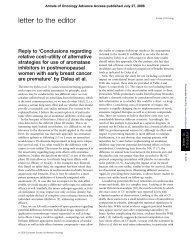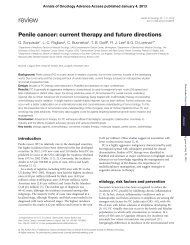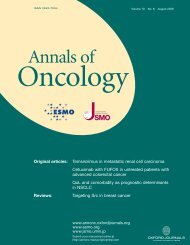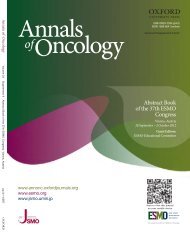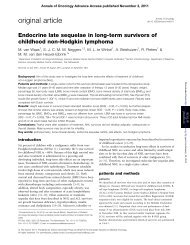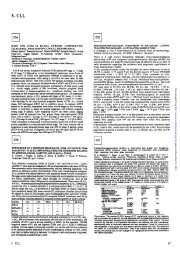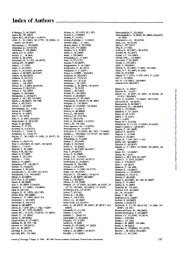Fentanyl buccal soluble film (FBSF) for breakthrough pain in patients ...
Fentanyl buccal soluble film (FBSF) for breakthrough pain in patients ...
Fentanyl buccal soluble film (FBSF) for breakthrough pain in patients ...
Create successful ePaper yourself
Turn your PDF publications into a flip-book with our unique Google optimized e-Paper software.
orig<strong>in</strong>al<br />
article<br />
orig<strong>in</strong>al article<br />
Annals of Oncology 21: 1308–1314, 2010<br />
doi:10.1093/annonc/mdp541<br />
Published onl<strong>in</strong>e 25 November 2009<br />
<strong>Fentanyl</strong> <strong>buccal</strong> <strong>soluble</strong> <strong>film</strong> (<strong>FBSF</strong>) <strong>for</strong> <strong>breakthrough</strong><br />
<strong>pa<strong>in</strong></strong> <strong>in</strong> <strong>patients</strong> with cancer: a randomized,<br />
double-bl<strong>in</strong>d, placebo-controlled study<br />
R. Rauck 1 , J. North 1 , L. N. Gever 2 , I. Tagarro 3 & A. L. F<strong>in</strong>n 4 *<br />
1 Carol<strong>in</strong>as Pa<strong>in</strong> Institute, W<strong>in</strong>ston-Salem, NC; 2 Meda Pharmaceuticals, Inc., Somerset, NJ, USA; 3 Meda Pharmaceuticals, Madrid, S<strong>pa<strong>in</strong></strong> and 4 BioDelivery Sciences<br />
International, Inc., Raleigh, NC, USA<br />
Received 11 August 2009; revised 14 October 2009; accepted 15 October 2009<br />
Background: <strong>Fentanyl</strong> <strong>buccal</strong> <strong>soluble</strong> <strong>film</strong> (<strong>FBSF</strong>) has been developed as a treatment of <strong>breakthrough</strong> <strong>pa<strong>in</strong></strong> <strong>in</strong> opioidtolerant<br />
<strong>patients</strong> with cancer. The objective of this study was to evaluate the efficacy of <strong>FBSF</strong> at doses of 200–1200 lg<br />
<strong>in</strong> the management of <strong>breakthrough</strong> <strong>pa<strong>in</strong></strong> <strong>in</strong> <strong>patients</strong> with cancer receiv<strong>in</strong>g ongo<strong>in</strong>g opioid therapy.<br />
Patients and methods: This was a multicenter, randomized, double-bl<strong>in</strong>d, placebo-controlled, multiple-crossover<br />
study that <strong>in</strong>cluded opioid-tolerant adult <strong>patients</strong> with chronic cancer <strong>pa<strong>in</strong></strong> who experienced one to four daily episodes<br />
of <strong>breakthrough</strong> <strong>pa<strong>in</strong></strong>. The primary efficacy assessment was the sum of <strong>pa<strong>in</strong></strong> <strong>in</strong>tensity differences at 30 m<strong>in</strong> (SPID30)<br />
postdose.<br />
Results: The <strong>in</strong>tent-to-treat population consisted of 80 <strong>patients</strong> with ‡1 post-basel<strong>in</strong>e efficacy assessment. The leastsquares<br />
mean (LSM 6 SEM) of the SPID30 was significantly greater <strong>for</strong> <strong>FBSF</strong>-treated episodes of <strong>breakthrough</strong> <strong>pa<strong>in</strong></strong><br />
than <strong>for</strong> placebo-treated episodes (47.9 6 3.9 versus 38.1 6 4.3; P = 0.004). There was statistical separation from<br />
placebo start<strong>in</strong>g at 15 m<strong>in</strong> up through 60 m<strong>in</strong> (last time po<strong>in</strong>t assessed). There were no unexpected adverse events<br />
(AEs) or cl<strong>in</strong>ically significant safety f<strong>in</strong>d<strong>in</strong>gs.<br />
Conclusions: <strong>FBSF</strong> is an effective option <strong>for</strong> control of <strong>breakthrough</strong> <strong>pa<strong>in</strong></strong> <strong>in</strong> <strong>patients</strong> receiv<strong>in</strong>g ongo<strong>in</strong>g opioid<br />
therapy. In this study, <strong>FBSF</strong> was well tolerated <strong>in</strong> the oral cavity, with no reports of treatment-related oral AEs.<br />
Key words: <strong>breakthrough</strong> cancer <strong>pa<strong>in</strong></strong>, cl<strong>in</strong>ical study, fentanyl <strong>buccal</strong> <strong>soluble</strong> <strong>film</strong><br />
<strong>in</strong>troduction<br />
Pa<strong>in</strong> related to chronic conditions such as cancer is often<br />
characterized by two components. The first component is<br />
persistent <strong>pa<strong>in</strong></strong>, and the recommended treatment is long-act<strong>in</strong>g<br />
opioid products. The second component is often referred to as<br />
‘<strong>breakthrough</strong> <strong>pa<strong>in</strong></strong>’. Breakthrough <strong>pa<strong>in</strong></strong> is def<strong>in</strong>ed as the<br />
‘transient exacerbation of <strong>pa<strong>in</strong></strong> occurr<strong>in</strong>g <strong>in</strong> a patient with<br />
otherwise controlled persistent <strong>pa<strong>in</strong></strong>’ [1]. An <strong>in</strong>ternational survey<br />
of 58 cl<strong>in</strong>icians <strong>in</strong> 24 countries evaluated a total of 1095 <strong>patients</strong><br />
with cancer <strong>pa<strong>in</strong></strong> of an <strong>in</strong>tensity that needed treatment with<br />
opioid analgesics to determ<strong>in</strong>e the prevalence of <strong>breakthrough</strong><br />
<strong>pa<strong>in</strong></strong> [2]. Breakthrough <strong>pa<strong>in</strong></strong> was reported <strong>in</strong> 64.8% of these<br />
<strong>patients</strong> and was associated with higher <strong>pa<strong>in</strong></strong> scores and<br />
functional impairment on the Brief Pa<strong>in</strong> Inventory [2].<br />
Breakthrough <strong>pa<strong>in</strong></strong> episodes have been rout<strong>in</strong>ely treated with<br />
oral short-act<strong>in</strong>g opioids, <strong>in</strong>clud<strong>in</strong>g hydrocodone,<br />
hydromorphone, morph<strong>in</strong>e, and oxycodone [3]. Although<br />
these treatments are widely used, the variable absorption of oral<br />
opioids from the gastro<strong>in</strong>test<strong>in</strong>al tract may result <strong>in</strong> delayed<br />
*Correspondence to: Dr A. L. F<strong>in</strong>n, BioDelivery Sciences International, Inc., 801<br />
Corporate Center Drive, Suite 210, Raleigh, NC 27607, USA. Tel: +1 (919) 582-9050;<br />
Fax: +1 (919) 582-9051; E-mail: af<strong>in</strong>n@bds<strong>in</strong>ternational.com<br />
<strong>pa<strong>in</strong></strong> relief (PR) (up to 40 m<strong>in</strong> after adm<strong>in</strong>istration) [4] and<br />
may lead to variability <strong>in</strong> the therapeutic effect. In a Pan-<br />
European survey [5], it was reported that 63% of <strong>patients</strong> with<br />
cancer receiv<strong>in</strong>g prescription analgesics reported <strong>breakthrough</strong><br />
<strong>pa<strong>in</strong></strong> or <strong>in</strong>adequate PR. Of those <strong>patients</strong>, 58% reported that<br />
they had <strong>in</strong>adequate PR at all times.<br />
As an alternative to oral adm<strong>in</strong>istration, transdermal and<br />
transmucosal routes of adm<strong>in</strong>istration have been used to<br />
deliver <strong>pa<strong>in</strong></strong> medication. With transmucosal delivery,<br />
absorption through the oral mucosa from either the <strong>buccal</strong><br />
cavity or subl<strong>in</strong>gually is more rapid than oral absorption [6].<br />
Other benefits of oral transmucosal delivery <strong>in</strong>clude<br />
m<strong>in</strong>imization of first-pass metabolism and better tolerance <strong>for</strong><br />
<strong>patients</strong> with dysphagia (especially dysphagia due to conditions<br />
such as head and neck cancer [7]) or those who have<br />
experienced nausea or vomit<strong>in</strong>g [8].<br />
<strong>Fentanyl</strong> is a potent opioid analgesic that is well absorbed via<br />
the oral mucosa. Currently, there are various <strong>for</strong>mulations<br />
approved by regulatory authorities. Oral transmucosal fentanyl<br />
citrate (OTFC) (United States and Europe: Actiq Ò ; Cephalon,<br />
Inc., Frazer, PA) is a <strong>buccal</strong> <strong>for</strong>mulation composed of a fentanyl<br />
lozenge on a stick. This <strong>for</strong>mulation requires patient ef<strong>for</strong>t <strong>for</strong><br />
adm<strong>in</strong>istration, and absorption is dependent on the <strong>in</strong>dividual<br />
application technique. A second <strong>buccal</strong> <strong>for</strong>mulation, the<br />
ª The Author 2009. Published by Ox<strong>for</strong>d University Press [on behalf of the European Society <strong>for</strong> Medical Oncology].<br />
This is an Open Access article distributed under the terms of the Creative Commons Attribution Non-Commercial License (http://creativecommons.org/licenses/by-nc/2.5/), which permits<br />
unrestricted non-commercial use, distribution, and reproduction <strong>in</strong> any medium, provided the orig<strong>in</strong>al work is properly cited.<br />
Downloaded from<br />
http://annonc.ox<strong>for</strong>djournals.org/ by guest on March 22, 2013
Annals of Oncology orig<strong>in</strong>al article<br />
fentanyl <strong>buccal</strong> tablet (FBT) (United States: Fentora Ò ; Europe:<br />
Effentora Ò ; Cephalon), has been approved <strong>in</strong> the United<br />
States and Europe. This <strong>for</strong>mulation utilizes an effervescence<br />
reaction that is postulated to be responsible of an enhanced<br />
fentanyl absorption through the <strong>buccal</strong> mucosa above that<br />
achievable with OTFC. More recently, a subl<strong>in</strong>gual tablet<br />
<strong>for</strong>mulation of fentanyl (Europe: Abstral Ò ;Orexo,Inc.,<br />
Uppsala, Sweden) that uses mucoadhesives to hold the<br />
fentanyl <strong>in</strong> contact with the mucosa membrane has been<br />
marketed <strong>in</strong> Europe.<br />
The most recent product to be approved by the United States<br />
Food and Drug Adm<strong>in</strong>istration, a fentanyl <strong>buccal</strong> <strong>soluble</strong> <strong>film</strong><br />
(<strong>FBSF</strong>) (United States: Onsolis Ò ; Meda Pharmaceuticals Inc.,<br />
Somerset, NJ; Europe: Breakyl Ò and Buquel Ò ), has been<br />
developed to control <strong>breakthrough</strong> <strong>pa<strong>in</strong></strong> <strong>in</strong> <strong>patients</strong> with cancer<br />
and is <strong>in</strong>tended <strong>for</strong> direct application to the oral mucosa. <strong>FBSF</strong><br />
utilizes BioErodible MucoAdhesive (BEMAä; BioDelivery<br />
Sciences, Inc., Raleigh, NC) technology to deliver fentanyl<br />
across the <strong>buccal</strong> mucosa. The technology uses a dual-layer<br />
polymer <strong>film</strong> consist<strong>in</strong>g of a mucoadhesive layer that conta<strong>in</strong>s<br />
the active drug and an <strong>in</strong>active layer that helps to prevent<br />
diffusion of drug <strong>in</strong>to the oral cavity. The mucoadhesive layer<br />
adheres to a moist mucosal membrane <strong>in</strong> seconds. <strong>FBSF</strong> starts<br />
to dissolve <strong>in</strong> m<strong>in</strong>utes and is completely dissolved with<strong>in</strong> 15–30<br />
m<strong>in</strong> after application without patient ef<strong>for</strong>t, requir<strong>in</strong>g only<br />
a m<strong>in</strong>imal amount of saliva to dissolve once adhered. Previous<br />
studies have shown that when delivered by this system, the<br />
proportion of the fentanyl dose that undergoes transmucosal<br />
absorption is 50% and the absolute bioavailability is 71%.<br />
The direct relationship between the surface area of the dose unit<br />
and the dose of fentanyl comb<strong>in</strong>ed with the mucosa contact time<br />
results <strong>in</strong> consistent plasma concentrations when equivalent<br />
doses are delivered by s<strong>in</strong>gle or multiple dosage units [9].<br />
The objective of the present study was to evaluate the efficacy<br />
and safety of <strong>FBSF</strong> at doses rang<strong>in</strong>g from 200 to 1200 lg <strong>in</strong> the<br />
management of <strong>breakthrough</strong> <strong>pa<strong>in</strong></strong> <strong>in</strong> <strong>patients</strong> with cancer<br />
receiv<strong>in</strong>g around the clock opioid therapy.<br />
methods<br />
trial design<br />
This was a multicenter, randomized, double-bl<strong>in</strong>d, placebo-controlled,<br />
crossover study compar<strong>in</strong>g <strong>FBSF</strong> with placebo <strong>for</strong> the treatment of<br />
<strong>breakthrough</strong> <strong>pa<strong>in</strong></strong> <strong>in</strong> <strong>patients</strong> with cancer receiv<strong>in</strong>g a stable opioid regimen<br />
<strong>for</strong> persistent <strong>pa<strong>in</strong></strong>. Breakthrough <strong>pa<strong>in</strong></strong> was def<strong>in</strong>ed as moderate-to-severe<br />
<strong>pa<strong>in</strong></strong> that occurred at a specific site <strong>for</strong> a transitory period aga<strong>in</strong>st<br />
a background of persistent <strong>pa<strong>in</strong></strong> controlled by the around the clock opioid<br />
regimen. The study consisted of a screen<strong>in</strong>g period of up to 1 week, an<br />
open-label titration period of up to 2 weeks, a double-bl<strong>in</strong>d period of up to<br />
2 weeks, and a 1-day follow-up. In the titration period, <strong>patients</strong> were issued<br />
an electronic diary and a dose-titration kit conta<strong>in</strong><strong>in</strong>g five doses of each of<br />
the five dose strengths (200, 400, 600, 800, and 1200 lg) of <strong>FBSF</strong>. Each<br />
subject started with the 200-lg dose and <strong>in</strong>creased their dose <strong>in</strong> a stepwise<br />
manner until adequate PR was achieved. Patients unable to identify a dose<br />
that produced satisfactory PR and those not complet<strong>in</strong>g the titration with<strong>in</strong><br />
2 weeks were discont<strong>in</strong>ued from the study. Patients who identified a dose<br />
that produced satisfactory PR <strong>for</strong> at least two target <strong>breakthrough</strong> <strong>pa<strong>in</strong></strong><br />
episodes were eligible to enter the double-bl<strong>in</strong>d crossover period. Dur<strong>in</strong>g<br />
the double-bl<strong>in</strong>d period, <strong>patients</strong> received n<strong>in</strong>e doses of study medication:<br />
six conta<strong>in</strong>ed fentanyl at the effective dose <strong>for</strong> that patient and three were<br />
placebo. The order <strong>in</strong> which the patient received <strong>FBSF</strong> or placebo was<br />
determ<strong>in</strong>ed by a computer-generated randomization code. At no time did<br />
<strong>patients</strong> receive two placebos <strong>in</strong> a row. Subjects were allowed to use their<br />
usual rescue medication if adequate PR was not realized with<strong>in</strong> 30 m<strong>in</strong>.<br />
Patients were not allowed to take another study dose <strong>for</strong> 4 h after their last<br />
dose of study drug. Any subsequent dose of study medication was <strong>for</strong> the<br />
emergence of a new target <strong>breakthrough</strong> <strong>pa<strong>in</strong></strong> episode and not an<br />
unresolved previously treated episode. Subjects rema<strong>in</strong>ed <strong>in</strong> the doublebl<strong>in</strong>d<br />
period of the study until all n<strong>in</strong>e doses of study medication were taken<br />
or until 14 days after entry <strong>in</strong>to the double-bl<strong>in</strong>d period of the study.<br />
The study protocol was approved by the <strong>in</strong>stitutional review board of<br />
each participat<strong>in</strong>g center. The study was conducted <strong>in</strong> accord with<br />
provisions of the World Medical Association Declaration of Hels<strong>in</strong>ki and its<br />
most recent amendment concern<strong>in</strong>g medical research <strong>in</strong> humans (2004)<br />
and con<strong>for</strong>med to all local laws and regulations (whichever provided the<br />
greater protection to <strong>in</strong>dividual <strong>patients</strong>). Documentation and procedures<br />
complied with the International Conference on Harmonisation Guidel<strong>in</strong>e<br />
E6 (R1) and the USA Code of Federal Regulations (Title 21, Part 50). All<br />
<strong>patients</strong> read and signed an approved <strong>in</strong><strong>for</strong>med consent <strong>for</strong>m be<strong>for</strong>e<br />
enrollment procedures commenced.<br />
<strong>patients</strong><br />
<strong>in</strong>clusion criteria. Patients eligible <strong>for</strong> the study were men or nonpregnant<br />
nonlactat<strong>in</strong>g women aged 18 years or older with <strong>pa<strong>in</strong></strong> associated with cancer<br />
or cancer treatment that required opioid therapy. The opioid dosage<br />
regimen must have been stable at the time of enrollment and was required<br />
to be equivalent to 60–1000 mg/day of oral morph<strong>in</strong>e or 50–300 lg/h of<br />
transdermal fentanyl. Eligible <strong>patients</strong> were experienc<strong>in</strong>g one to four<br />
episodes of <strong>breakthrough</strong> <strong>pa<strong>in</strong></strong> daily that required opioids <strong>for</strong> <strong>pa<strong>in</strong></strong> control,<br />
<strong>for</strong> which opioids provided at least partial relief.<br />
exclusion criteria. Patients with more than four episodes of <strong>breakthrough</strong><br />
<strong>pa<strong>in</strong></strong> per day and those with rapidly escalat<strong>in</strong>g <strong>pa<strong>in</strong></strong> that the <strong>in</strong>vestigator<br />
believed may require an <strong>in</strong>crease <strong>in</strong> the dosage of the background opioid<br />
were not eligible <strong>for</strong> the study, as were those who had received strontium 89<br />
dur<strong>in</strong>g the previous 6 months and those receiv<strong>in</strong>g any other therapy that<br />
could alter <strong>pa<strong>in</strong></strong> or the patient’s response to <strong>pa<strong>in</strong></strong> medication.<br />
drug adm<strong>in</strong>istration<br />
Eligible <strong>patients</strong> received <strong>in</strong>struction on handl<strong>in</strong>g and application of <strong>FBSF</strong><br />
dose units. Patients were <strong>in</strong>structed to apply the mucoadhesive side of the<br />
th<strong>in</strong> <strong>film</strong> unit (about half the thickness of a bus<strong>in</strong>ess card or roughly<br />
equivalent to 2.5 dollar bills) to a moistened (saliva or water) <strong>buccal</strong><br />
mucosa and to hold it <strong>in</strong> place <strong>for</strong> 5 s. The <strong>FBSF</strong> dose unit adheres to the<br />
mucosal membrane, becom<strong>in</strong>g pliable with<strong>in</strong> a m<strong>in</strong>ute, and then<br />
completely dissolves over a period of 15–30 m<strong>in</strong>.<br />
Patients were allowed to use their usual rescue medication 30 m<strong>in</strong> after<br />
self-adm<strong>in</strong>istration of a study dose <strong>for</strong> episodes of <strong>pa<strong>in</strong></strong> that were not<br />
adequately controlled by the study medication.<br />
assessments<br />
efficacy. Pa<strong>in</strong> <strong>in</strong>tensity (PI) and PR were assessed at 5, 10, 15, 30, 45, and 60<br />
m<strong>in</strong> after each double-bl<strong>in</strong>d study dose. PI was measured on an 11-po<strong>in</strong>t<br />
scale (0 = no <strong>pa<strong>in</strong></strong> and 10 = worst <strong>pa<strong>in</strong></strong>) and the PI difference calculated as<br />
the basel<strong>in</strong>e PI m<strong>in</strong>us the assessment po<strong>in</strong>t PI. PR was measured on a<br />
5-po<strong>in</strong>t scale (0 = no relief to 4 = complete relief). PI differences (PID =<br />
basel<strong>in</strong>e PI m<strong>in</strong>us PI at assessment po<strong>in</strong>t) were calculated, and the weighted<br />
sum over the first 30 m<strong>in</strong> postdose (SPID30) was def<strong>in</strong>ed as the primary<br />
outcome measure. Secondary outcome measures <strong>in</strong>cluded PID and PR<br />
calculated at various time po<strong>in</strong>ts throughout the study period and the sums<br />
of PID (SPID) were calculated over various <strong>in</strong>tervals. Global satisfaction<br />
was assessed on a 5-po<strong>in</strong>t scale (poor, fair, good, very good, and excellent)<br />
at the time of rescue or 60 m<strong>in</strong> after study dose.<br />
Volume 21 | No. 6 | June 2010 doi:10.1093/annonc/mdp541 | 1309<br />
Downloaded from<br />
http://annonc.ox<strong>for</strong>djournals.org/ by guest on March 22, 2013
orig<strong>in</strong>al article<br />
safety. A complete medical history, <strong>in</strong>clud<strong>in</strong>g cancer diagnosis, recent<br />
therapeutic decisions, and drug history, was assessed at the screen<strong>in</strong>g visit.<br />
A complete physical exam<strong>in</strong>ation was carried out and vital signs measured<br />
at the screen<strong>in</strong>g and follow-up visits. Adverse events (AEs) were reported<br />
and assessed throughout the study with an electronic diary. Concomitant<br />
medications were monitored throughout the study.<br />
statistical analyses<br />
Efficacy analyses were conducted us<strong>in</strong>g the <strong>in</strong>tent-to-treat (ITT)<br />
population, def<strong>in</strong>ed as all <strong>patients</strong> who entered the double-bl<strong>in</strong>d phase of<br />
the trial, who took at least one dose of study medication and had at least<br />
one <strong>pa<strong>in</strong></strong> assessment with<strong>in</strong> the 30-m<strong>in</strong> postdose period. The safety<br />
population was def<strong>in</strong>ed as all <strong>patients</strong> who received at least one dose of<br />
study medication <strong>in</strong> the dose-titration and double-bl<strong>in</strong>d treatment phases<br />
of the study.<br />
All statistical analyses were carried out by us<strong>in</strong>g a two-sided hypothesis<br />
test with a type I error (alpha) of 0.05 (i.e., a 5% level of statistical<br />
significance). Efficacy data are presented as least-squares means (LSM) and<br />
standard errors. The primary efficacy parameter, SPID30, was analyzed<br />
us<strong>in</strong>g a mixed model of repeated measures with fixed effects <strong>for</strong> treatment,<br />
Figure 1. Flow of <strong>patients</strong> through the study. ITT, <strong>in</strong>tent-to-treat; PP, per protocol.<br />
pooled site, and a random effect <strong>for</strong> subjects. The secondary efficacy<br />
parameters were analyzed us<strong>in</strong>g the one-sample Wilcoxon signed rank test.<br />
results<br />
Annals of Oncology<br />
patient disposition and demographics<br />
The study was conducted at 30 cl<strong>in</strong>ical sites <strong>in</strong> the United States<br />
between 24 February 2006 and 14 March 2007. A total of 152<br />
<strong>patients</strong> were screened and enrolled <strong>in</strong> the study, and 151<br />
<strong>patients</strong> received at least one dose of study medication and were<br />
<strong>in</strong>cluded <strong>in</strong> the safety population (Figure 1).<br />
Of the 151 <strong>patients</strong> enrolled <strong>in</strong> the titration phase, 69 (45.7%)<br />
discont<strong>in</strong>ued the study. The reasons <strong>for</strong> withdrawal were the<br />
follow<strong>in</strong>g: 17 (11.3%) <strong>for</strong> AEs, 15 (9.9%) because of difficulties or<br />
noncompliance with the electronic diary, 14 (9.3%) withdrew<br />
consent without explanation, 8 (5.3%) were withdrawn <strong>for</strong><br />
protocol violations, 7 (4.6%) because they had less than a s<strong>in</strong>gle<br />
episode of <strong>breakthrough</strong> <strong>pa<strong>in</strong></strong> a day, 5 (3.3%) <strong>for</strong> lack of efficacy,<br />
and 3 (2.0%) <strong>patients</strong> <strong>for</strong> adm<strong>in</strong>istrative reasons.<br />
1310 | Rauck et al. Volume 21 | No. 6 | June 2010<br />
Downloaded from<br />
http://annonc.ox<strong>for</strong>djournals.org/ by guest on March 22, 2013
Annals of Oncology orig<strong>in</strong>al article<br />
Twelve <strong>patients</strong> (7.9%) discont<strong>in</strong>ued prematurely from the<br />
double-bl<strong>in</strong>d phase of the study <strong>for</strong> the follow<strong>in</strong>g reasons: 4<br />
(4.9%) withdrew consent, 3 (3.7%) because of AEs, 2 (2.4%)<br />
<strong>for</strong> noncompliance with the electronic diary, 2 (2.4%) <strong>for</strong> not<br />
consistently treat<strong>in</strong>g one episode of <strong>pa<strong>in</strong></strong> per day, and 1 (1.2%)<br />
<strong>for</strong> lack of efficacy.<br />
A total of 70 <strong>patients</strong> <strong>in</strong> the safety population did not receive<br />
any study drug <strong>in</strong> the double-bl<strong>in</strong>d treatment phase of the<br />
study, and 1 patient did not have a <strong>pa<strong>in</strong></strong> assessment with<strong>in</strong> 30<br />
m<strong>in</strong> of tak<strong>in</strong>g a dose of study drug dur<strong>in</strong>g the double-bl<strong>in</strong>d<br />
phase of the study; thus, the ITT population consisted of 80<br />
<strong>patients</strong>.<br />
A summary of the demographic characteristics of <strong>patients</strong><br />
<strong>in</strong>cluded <strong>in</strong> the safety and efficacy populations is provided <strong>in</strong><br />
Table 1. There were no important differences <strong>in</strong> the basel<strong>in</strong>e<br />
characteristics of the safety and ITT populations. Breast cancer<br />
(23%), lung cancer (17%), colorectal cancer (11%),<br />
gastroesophageal cancer (7%), pancreatic cancer (6%), and<br />
head and neck cancer (5%) were the most common cancer<br />
types <strong>in</strong> the safety population. Overall, <strong>patients</strong> had suffered<br />
from the current primary cancer <strong>for</strong> a mean period of 3.2 years<br />
with a median of 1.6 years and a range of 30 years. More<br />
than half of the <strong>patients</strong> (55.6%) had received chemotherapy<br />
and one-quarter (25.2%) had received radiation therapy <strong>in</strong> the<br />
last 6 months be<strong>for</strong>e study entry.<br />
For approximately half of the <strong>patients</strong> <strong>in</strong> the safety<br />
population, the <strong>pa<strong>in</strong></strong> pathophysiology <strong>for</strong> both persistent <strong>pa<strong>in</strong></strong><br />
and target <strong>breakthrough</strong> <strong>pa<strong>in</strong></strong> was somatic and/or visceral.<br />
Forty-n<strong>in</strong>e <strong>patients</strong> (32.5%) also experienced neuropathic <strong>pa<strong>in</strong></strong>.<br />
For most <strong>patients</strong> <strong>in</strong> the safety population, the <strong>pa<strong>in</strong></strong> syndrome<br />
Table 1. Demographic data<br />
Demographic Safety population<br />
(n = 151)<br />
Efficacy (ITT)<br />
population<br />
(n = 80)<br />
Gender, n (%)<br />
Male 66 (44) 36 (45)<br />
Female 85 (56) 44 (55)<br />
Mean (SD) age <strong>in</strong> years<br />
Age <strong>in</strong> years, n (%)<br />
57.1 (12.2) 56.8 (13.0)<br />
orig<strong>in</strong>al article<br />
Figure 2. Mean sum of <strong>pa<strong>in</strong></strong> <strong>in</strong>tensity difference (SPID) scores over<br />
time.*P < 0.05; **P < 0.01; ***P < 0.001. SEM, standard error of the mean.<br />
Figure 3. Mean <strong>pa<strong>in</strong></strong> <strong>in</strong>tensity difference over time.*P < 0.05; **P < 0.01;<br />
***P < 0.001. SEM, standard error of the mean.<br />
compared with placebo (Figure 4). The mean (6 SEM) number<br />
of episodes when rescue medication was used was significantly<br />
lower after treatment with <strong>FBSF</strong> than with placebo (30.0% 6<br />
3.5% versus 44.6% 6 4.4%; P = 0.002).<br />
safety<br />
Twenty-three <strong>patients</strong> (15.2%) experienced 29 serious AEs.<br />
None of these serious AEs were considered to be related to the<br />
study drug. Respiratory depression was not reported by any<br />
patient enrolled <strong>in</strong> the study. There were four deaths dur<strong>in</strong>g the<br />
study, none of which were considered to be study drug related.<br />
Twenty-one <strong>patients</strong> (13.9%) discont<strong>in</strong>ued study drug<br />
adm<strong>in</strong>istration because of treatment-emergent AEs, <strong>in</strong>clud<strong>in</strong>g 9<br />
serious AEs and 12 nonserious AEs. Nausea and vomit<strong>in</strong>g were<br />
the most common AEs lead<strong>in</strong>g to permanent study drug<br />
discont<strong>in</strong>uation (3.3% of <strong>patients</strong>, respectively).<br />
Treatment-emergent AEs were reported by 75 <strong>patients</strong><br />
(49.7% of 151 <strong>patients</strong>) dur<strong>in</strong>g the titration period and 34<br />
<strong>patients</strong> (42% of 81 <strong>patients</strong>) dur<strong>in</strong>g the double-bl<strong>in</strong>d period.<br />
The most common treatment-emergent AEs were typical of<br />
opioid adm<strong>in</strong>istration and occurred with similar frequency<br />
dur<strong>in</strong>g the titration and double-bl<strong>in</strong>d phases. Treatmentemergent<br />
AEs reported dur<strong>in</strong>g the titration phase <strong>in</strong>cluded<br />
nausea (9.3%), vomit<strong>in</strong>g (9.3%), somnolence (6.0%), dizz<strong>in</strong>ess<br />
(4.6%), and headache (4.0%). Treatment-emergent AEs<br />
reported dur<strong>in</strong>g the double-bl<strong>in</strong>d phase <strong>in</strong>cluded nausea<br />
(9.9%), vomit<strong>in</strong>g (9.9%), and headache (1.2%).<br />
Most AEs [213 of 273 (78.0%)] <strong>in</strong> 47 <strong>patients</strong> were not<br />
considered to be drug related. A total of 56 drug-related AEs<br />
were reported by 37 of the 151 <strong>patients</strong> (24.5%) <strong>in</strong>cluded <strong>in</strong> the<br />
safety population. One patient had four AEs, and it could not<br />
be determ<strong>in</strong>ed whether those events were drug related. The<br />
most common drug-related AEs were gastro<strong>in</strong>test<strong>in</strong>al disorders<br />
and central nervous system disorders (Table 3). These AEs<br />
<strong>in</strong>cluded somnolence (6.0%), nausea (5.3%), dizz<strong>in</strong>ess (4.6%),<br />
and vomit<strong>in</strong>g (4.0%). These AEs are commonly associated with<br />
opioid therapy.<br />
Only five <strong>patients</strong> (3.3%) reported oral AEs (n = 2, mild<br />
mucosal <strong>in</strong>flammation; n = 3, oral candidiasis) and all these<br />
events were considered to be unrelated to study treatment <strong>in</strong><br />
the op<strong>in</strong>ion of the <strong>in</strong>vestigator. No oral ulcerations, <strong>pa<strong>in</strong></strong>, or<br />
edema associated with the study drug were observed <strong>in</strong> the<br />
study population.<br />
discussion<br />
Annals of Oncology<br />
The results of this study demonstrate that <strong>FBSF</strong> is more<br />
effective than placebo <strong>for</strong> the management of <strong>breakthrough</strong><br />
<strong>pa<strong>in</strong></strong> <strong>in</strong> opioid-tolerant <strong>patients</strong> with cancer. The SPID values<br />
were significantly greater <strong>for</strong> <strong>FBSF</strong>-treated episodes than <strong>for</strong><br />
placebo-treated episodes beg<strong>in</strong>n<strong>in</strong>g 15 m<strong>in</strong> after drug<br />
adm<strong>in</strong>istration and cont<strong>in</strong>u<strong>in</strong>g through 60 m<strong>in</strong>. Similarly, <strong>pa<strong>in</strong></strong><br />
scores <strong>for</strong> <strong>FBSF</strong>-treated episodes were significantly lower than<br />
<strong>for</strong> placebo-treated episodes at 30, 45, and 60 m<strong>in</strong> after dos<strong>in</strong>g.<br />
At 30 m<strong>in</strong> postdose, reductions <strong>in</strong> PI of at least 33% and of at<br />
least 50% were obta<strong>in</strong>ed <strong>in</strong> significantly more <strong>FBSF</strong>-treated<br />
episodes than <strong>in</strong> placebo-treated episodes (P = 0.009 and<br />
P = 0.002, respectively). Patients gave favorable rat<strong>in</strong>gs to<br />
a numerically higher proportion of <strong>pa<strong>in</strong></strong> episodes treated with<br />
<strong>FBSF</strong> than with placebo (P < 0.001).<br />
Of 152 <strong>patients</strong> on stable opioid therapy <strong>for</strong> cancer <strong>pa<strong>in</strong></strong> who<br />
entered the dose-titration phase of the study, 53.9% entered the<br />
double-bl<strong>in</strong>d phase. The most common reasons <strong>for</strong> dropout<br />
from the titration phase were noncompliance with study<br />
procedures, <strong>in</strong>clud<strong>in</strong>g use of the electronic diary card. Of the<br />
subjects who began titration, 3.3% did not cont<strong>in</strong>ue <strong>in</strong> the<br />
study because they were not able to f<strong>in</strong>d an effective dose of<br />
<strong>FBSF</strong> <strong>for</strong> <strong>breakthrough</strong> <strong>pa<strong>in</strong></strong>.<br />
It has been reported that more than half of <strong>patients</strong> receiv<strong>in</strong>g<br />
prescription medic<strong>in</strong>e <strong>for</strong> cancer <strong>pa<strong>in</strong></strong> experience <strong>in</strong>adequate<br />
PR or <strong>breakthrough</strong> <strong>pa<strong>in</strong></strong> [5]. This f<strong>in</strong>d<strong>in</strong>g <strong>in</strong>dicates that<br />
additional pharmacotherapeutics that are well tolerated and<br />
have rapid onsets of action are needed to treat this patient<br />
population. Transmucosal fentanyl preparations are approved<br />
<strong>in</strong> the United States <strong>for</strong> the treatment of <strong>breakthrough</strong> <strong>pa<strong>in</strong></strong> <strong>in</strong><br />
<strong>patients</strong> with cancer, <strong>in</strong>clud<strong>in</strong>g OTFC, FBT [10, 11], and <strong>FBSF</strong>.<br />
OTFC has been shown to provide more effective PR than<br />
immediate-release morph<strong>in</strong>e <strong>in</strong> a study population similar to<br />
1312 | Rauck et al. Volume 21 | No. 6 | June 2010<br />
Downloaded from<br />
http://annonc.ox<strong>for</strong>djournals.org/ by guest on March 22, 2013
Annals of Oncology orig<strong>in</strong>al article<br />
Table 2. Percentage of episodes with decreases <strong>in</strong> <strong>pa<strong>in</strong></strong> scores (mean 6 SEM)<br />
Parameter Treatment Time post-adm<strong>in</strong>istration<br />
(m<strong>in</strong>)<br />
15 30 45 60<br />
Percentage of episodes with<br />
‡33% reduction <strong>in</strong> <strong>pa<strong>in</strong></strong><br />
scores<br />
Percentage of episodes with<br />
‡50% reduction <strong>in</strong> <strong>pa<strong>in</strong></strong><br />
scores<br />
<strong>FBSF</strong>, fentanyl <strong>buccal</strong> <strong>soluble</strong> <strong>film</strong>.<br />
Figure 4. Overall satisfaction with study drug.<br />
Table 3. Incidence of drug-related adverse events that occurred <strong>in</strong> two<br />
or more <strong>patients</strong> (n = 151)<br />
Adverse event Incidence, n (%)<br />
Somnolence 9 (6.0)<br />
Nausea 8 (5.3)<br />
Dizz<strong>in</strong>ess 7 (4.6)<br />
Vomit<strong>in</strong>g 6 (4.0)<br />
Headache 4 (2.6)<br />
Constipation 3 (2.0)<br />
Dry mouth 2 (1.3)<br />
Dysgeusia 2 (1.3)<br />
Pruritus 2 (1.3)<br />
Confusional state 2 (1.3)<br />
the group described <strong>in</strong> the current study [12]. <strong>FBSF</strong> has been<br />
shown to produce plasma fentanyl concentrations earlier and<br />
greater than an equal dose of OTFC <strong>in</strong> normal volunteers [13].<br />
<strong>FBSF</strong> was safe and well tolerated by <strong>patients</strong> enrolled <strong>in</strong> this<br />
study. The AEs reported dur<strong>in</strong>g the study were typical of those<br />
associated with opioid analgesics. No <strong>patients</strong> experienced<br />
respiratory depression and none of the serious AEs were<br />
considered to be study drug related. No drug-related oral AEs<br />
<strong>FBSF</strong> 26.4 (3.55) 47.3 (4.05) 57.5 (3.93) 64.3 (3.72)<br />
Placebo 21.3 (3.66) 38.2 (4.45) 46.5 (4.50) 48.2 (4.51)<br />
P value 0.100 0.009 0.004
orig<strong>in</strong>al article<br />
In conclusion, <strong>FBSF</strong> is an effective option <strong>for</strong> control of<br />
<strong>breakthrough</strong> <strong>pa<strong>in</strong></strong> <strong>in</strong> <strong>patients</strong> receiv<strong>in</strong>g ongo<strong>in</strong>g opioid<br />
therapy. In this study, <strong>FBSF</strong> was well tolerated and there were<br />
no reports of treatment-related AEs.<br />
fund<strong>in</strong>g<br />
BioDelivery Sciences International.<br />
acknowledgement<br />
Editorial assistance was provided by Blair J. Jarvis, MSc, M. K.<br />
Grandison, PhD, and Carol A. Lewis, PhD.<br />
disclosure<br />
LNG and IT are employees of Meda Pharmaceuticals. ALF is an<br />
employee and shareholder of BioDelivery Sciences<br />
International, the developer of <strong>FBSF</strong>.<br />
references<br />
1. Portenoy RK, Hagen NA. Breakthrough <strong>pa<strong>in</strong></strong>: def<strong>in</strong>ition, prevalence and<br />
characteristics. Pa<strong>in</strong> 1990; 41: 273–281.<br />
2. Caraceni A, Mart<strong>in</strong>i C, Zecca E et al. Breakthrough <strong>pa<strong>in</strong></strong> characteristics and<br />
syndromes <strong>in</strong> <strong>patients</strong> with cancer <strong>pa<strong>in</strong></strong>. An <strong>in</strong>ternational survey. Palliat Med<br />
2004; 18: 177–183.<br />
3. Farrar JT, Cleary J, Rauck R et al. Oral transmucosal fentanyl citrate:<br />
randomized, double-bl<strong>in</strong>ded, placebo-controlled trial <strong>for</strong> treatment of<br />
<strong>breakthrough</strong> <strong>pa<strong>in</strong></strong> <strong>in</strong> cancer <strong>patients</strong>. J Natl Cancer Inst 1998; 90:<br />
611–616.<br />
4. William L, Macleod R. Management of <strong>breakthrough</strong> <strong>pa<strong>in</strong></strong> <strong>in</strong> <strong>patients</strong> with cancer.<br />
Drugs 2008; 68: 913–924.<br />
Annals of Oncology<br />
5. Breivik H, Cherny N, Collett B et al. Cancer-related <strong>pa<strong>in</strong></strong>: a pan-European survey of<br />
prevalence, treatment, and patient attitudes. Ann Oncol 2009; 20: 1420–1433.<br />
6. Well<strong>in</strong>g P. Pharmacok<strong>in</strong>etics: Processes, Mathematics and Applications.<br />
Wash<strong>in</strong>gton, DC: American Chemical Society 1997.<br />
7. De Conno F, Groff L, Brunelli C et al. Cl<strong>in</strong>ical experience with oral methadone<br />
adm<strong>in</strong>istration <strong>in</strong> the treatment of <strong>pa<strong>in</strong></strong> <strong>in</strong> 196 advanced cancer <strong>patients</strong>. J Cl<strong>in</strong><br />
Oncol 1996; 14: 2836–2842.<br />
8. Zhang H, Zhang J, Streisand JB. Oral mucosal drug delivery: cl<strong>in</strong>ical pharmacok<strong>in</strong>etics<br />
and therapeutic applications. Cl<strong>in</strong> Pharmacok<strong>in</strong>et 2002; 41: 661–680.<br />
9. Vasisht N, Stark J, F<strong>in</strong>n A. BEMA fentanyl shows a favorable pharmacok<strong>in</strong>etic<br />
profile and dose l<strong>in</strong>earity <strong>in</strong> healthy volunteers. In 2008 Annual General Meet<strong>in</strong>g<br />
of the American Society of Anesthesiologists.<br />
10. Anesta Corp. Actiq (<strong>Fentanyl</strong> Citrate) Oral Transmucosal Lozenge. Prescrib<strong>in</strong>g<br />
In<strong>for</strong>mation. Revised. Actiq (<strong>Fentanyl</strong> Citrate) Oral Transmucosal Lozenge<br />
[Prescrib<strong>in</strong>g <strong>in</strong><strong>for</strong>mation]. Frazer, PA: Cephalon, Inc; 2007.<br />
11. Cephalon Inc. Fentora (<strong>Fentanyl</strong> Buccal Tablet). Prescrib<strong>in</strong>g In<strong>for</strong>mation. Revised.<br />
Actiq (<strong>Fentanyl</strong> Citrate) Oral Transmucosal Lozenge [Prescrib<strong>in</strong>g <strong>in</strong><strong>for</strong>mation].<br />
Frazer, PA: Cephalon, Inc; 2007.<br />
12. Coluzzi PH, Schwartzberg L, Conroy JD et al. Breakthrough cancer <strong>pa<strong>in</strong></strong>:<br />
a randomized trial compar<strong>in</strong>g oral transmucosal fentanyl citrate (OTFC) and<br />
morph<strong>in</strong>e sulfate immediate release (MSIR). Pa<strong>in</strong> 2001; 91: 123–130.<br />
13. Vasisht N, Gever LN, Tagarro I, F<strong>in</strong>n AL. Formulation selection and pharmacok<strong>in</strong>etic<br />
comparison of fentanyl <strong>buccal</strong> <strong>soluble</strong> <strong>film</strong> with oral transmucosal fentanyl citrate:<br />
a randomized, open-label, s<strong>in</strong>gle-dose, crossover study. Cl<strong>in</strong> Drug Investig 2009;<br />
29(10): 647–654.<br />
14. Portenoy RK, Taylor D, Mess<strong>in</strong>a J, Tremmel L. A randomized, placebo-controlled<br />
study of fentanyl <strong>buccal</strong> tablet <strong>for</strong> <strong>breakthrough</strong> <strong>pa<strong>in</strong></strong> <strong>in</strong> opioid-treated <strong>patients</strong><br />
with cancer. Cl<strong>in</strong> J Pa<strong>in</strong> 2006; 22: 805–811.<br />
15. Beecher HK. The powerful placebo. J Am Med Assoc 1955; 159: 1602–1606.<br />
16. Enck P, Benedetti F, Schedlowski M. New <strong>in</strong>sights <strong>in</strong>to the placebo and nocebo<br />
responses. Neuron 2008; 59: 195–206.<br />
17. F<strong>in</strong>niss DG, Benedetti F. Mechanisms of the placebo response and their impact<br />
on cl<strong>in</strong>ical trials and cl<strong>in</strong>ical practice. Pa<strong>in</strong> 2005; 114: 3–6.<br />
18. Benedetti F. Mechanisms of placebo and placebo-related effects across diseases<br />
and treatments. Annu Rev Pharmacol Toxicol 2008; 48: 33–60.<br />
1314 | Rauck et al. Volume 21 | No. 6 | June 2010<br />
Downloaded from<br />
http://annonc.ox<strong>for</strong>djournals.org/ by guest on March 22, 2013



